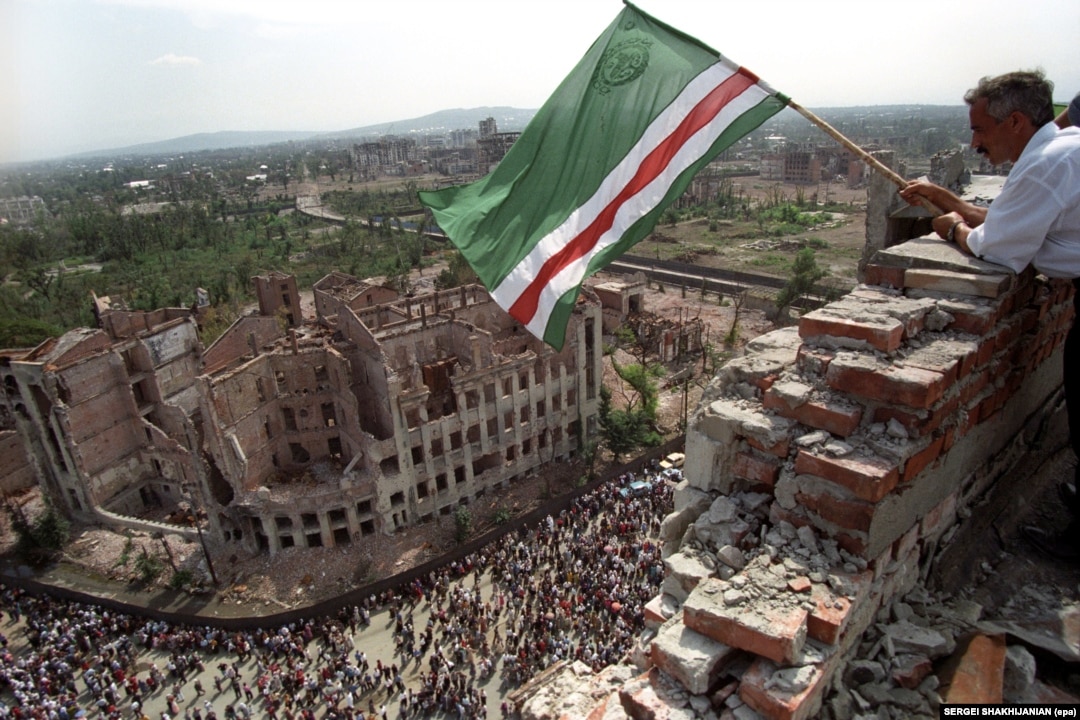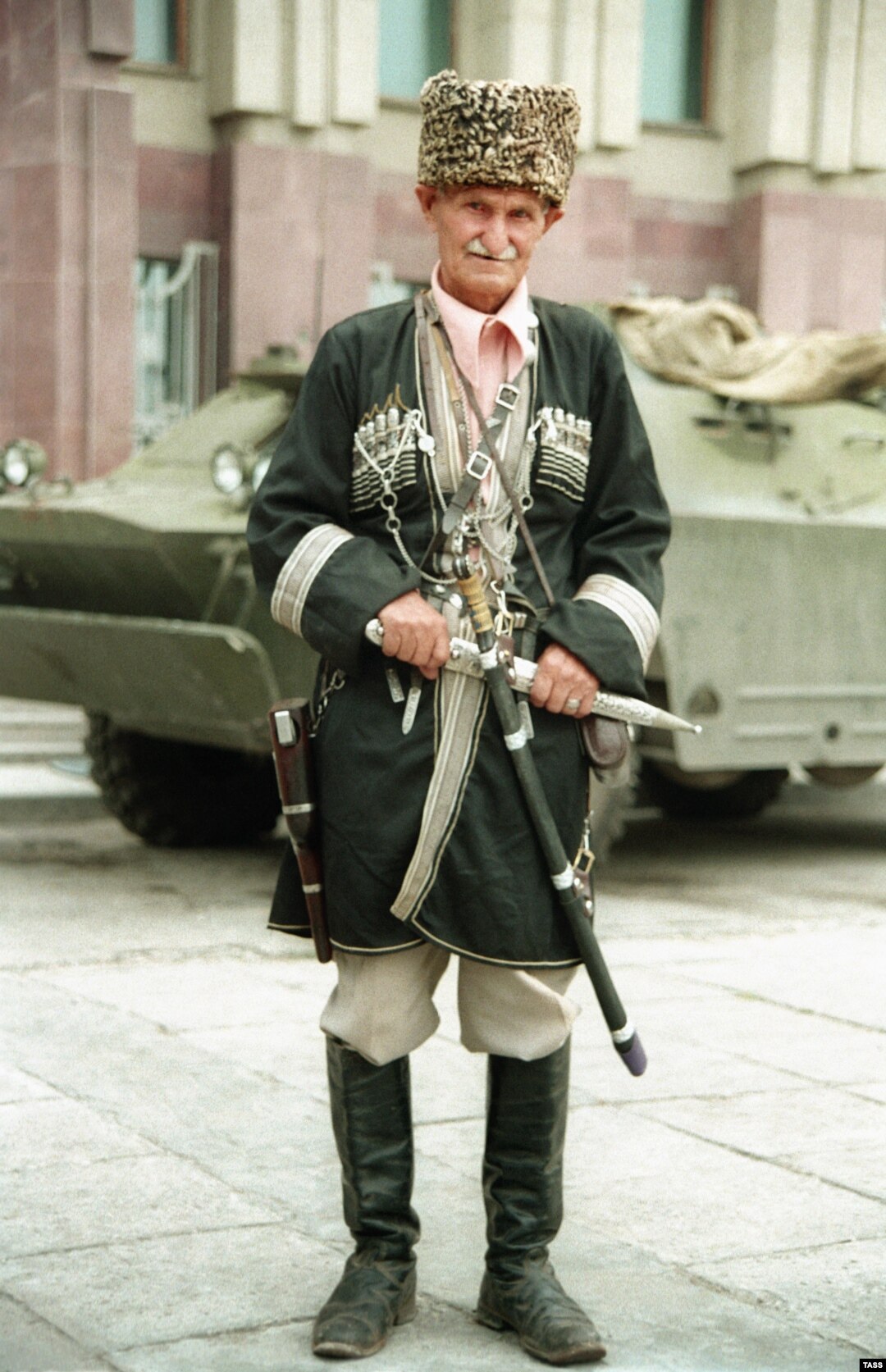'Welcome To Hell, Part II': The Second Chechen War

A man waving a separatist Chechen flag in Grozny, the region’s capital, in 1995. Many buildings were destroyed by Russian bombs and other weaponry in the 1994-96 war between federal troops and Chechen rebels, which ended with de facto independence for Chechnya.

A Chechen man in 1994. The Kremlin has a centuries-long history of conflict and near-genocidal repression of Chechens, who have been seen by many in Russia as particularly defiant. Aleksandr Solzhenitsyn described Chechen fellow prisoners in the Soviet gulag as the one ethnic group whose members “refused to accept the psychology of submission.”

A man being flogged in Grozny in 1996. The devastation of the war and the relative isolation that followed made Chechnya a breeding ground for extremism, and street violence became a major problem. In 1997, the region adopted Shari'a law and began to carry out public executions.
Russian soldiers fight militants after insurgents crossed into neighboring Daghestan and launched attacks, one of the catalysts of the second post-Soviet war in Chechnya.
Another major catalyst of the war was a series of apartment-building bombings that killed more than 300 people in Moscow and two other cities. Putin blamed “terrorists” in Chechnya and ordered a massive air campaign; the mysterious circumstances gave rise to persistent suspicions that the bombings were planned by the Kremlin to justify what was about to unfold.
On October 1, 1999, Putin ordered a ground offensive into Chechnya. These forces are pictured on October 2.
Russian federal soldiers fire at Chechen rebel positions. The ground assault was backed by heavy use of artillery and air power.
Chechen fighters watch federal troops through their rifle scopes on October 17.
Russian attack helicopters buzz a village in Chechnya. Use of long-range weaponry resulted in relatively easy gains for the Russian forces, but heavy civilian casualties.
A Russian Tochka missile, capable of carrying half a ton of explosives, is launched towards a road used by Chechen rebels in November 1999. Russian forces fired several tactical ballistic missiles that slammed into central Grozny on October 21, killing more than 100 people instantly and sparking international outrage.
Oil fields in Chechnya, which is one of several oil-producing regions in Russia and has a pipeline running across its territory. The Russian military was reportedly involved in profiteering from Chechnya’s oil wealth throughout the 1990s.
The words “Welcome to Hell, Part II” painted in red on a hunk of concrete on the outskirts of Grozny. The other wording refers to a unit of federal forces from the Irkutsk region, far away in eastern Siberia, and says: “We’re back.”
Federal troops during a firefight in Grozny in January 2000.
Troops raise a Russian flag in the center of Grozny in February 2000. By the time federal forces recaptured the city, much of it had been reduced to ruins by Russian bombs and by other weapons in the fighting.
A woman picks her way through the rubble in Grozny. After being targeted twice in less than a decade, Chechnya’s capital was the most destroyed city on earth.
Russian marines on patrol in February 2000. After the capture of Grozny, militants operated from the mountains and forests in a new phase of the war.
Chechen fighters resting in a forest near Grozny in December 1999.
A Russian military position in the mountains of Chechnya in April 2000.
As federal troops fanned out into the mountains, the war became known for ambushes and killings by Islamist militants, some foreign-born, and massively lethal Russian attacks on civilian centers.
A Russian serviceman during the battle of Komsomolskoye, a village where more than 700 people, many of them civilians, were killed in March 2000. Later that spring Putin, elected president in March and inaugurated in May, imposed direct Kremlin rule over Chechnya.
In October 2002, Islamist militants burst into a Moscow theater and took nearly 1,000 audience members, actors, and others hostage, demanding the withdrawal of federal troops from Chechnya. Authorities said all the attackers were killed when security forces stormed the theater three days later, but 130 hostages also died, many from the effects of a potent gas pumped into the building before what critics said was a badly botched rescue operation.
The 2002 theater siege was followed by several other attacks on civilians outside Chechnya by militants citing the Kremlin’s operation there. On September 1, 2004, attackers seized a school in North Ossetia, which borders Chechnya, taking more than 1,100 pupils, parents, and staff hostage and demanding a withdrawal from Chechnya, among other things. Russian special forces launched a rescue operation that critics said was bungled, and the three-day Beslan ordeal ended with 334 people dead, including 186 children.
In March 2000 Akhmad Kadyrov (left) was appointed acting head of the Chechen administration. The separatist fighter turned pro-Kremlin politician was assassinated in 2004. His son Ramzan (right) was appointed president of Chechnya by Putin in 2007 and remains in the top post. Chechnya has been rebuilt with large infusions of money from Moscow but rights groups say Kadyrov rules through violence and intimidation and is responsible for years of severe abuses including abductions, torture, and killings.
In April 2009, Moscow declared its “counterterrorism operation” in Chechnya had ended. The conflict is estimated to have killed some 50,000 to 80,000 people, most of them civilians.

